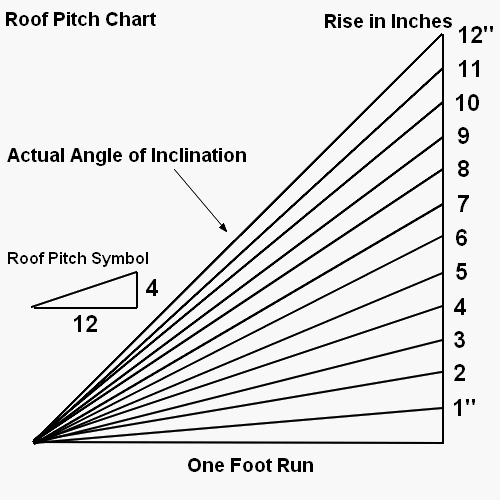Determining Roof Pitch
Roof pitch is determined by finding the amount of rise per foot run. If you are framing a new home,
garage, shed, or similar building the pitch of the roof can be obtained
by looking on the plans. It is represented by a triangular shaped
drawing and expressed in inches, 4/12, 5/12, etc. the higher the number
the steeper the pitch or angle of incline.
When building an addition it is often necessary to tie the new roof into an existing one. In order to tie the two together the existing pitch must be known.
Find Existing Roof Pitch
New Roof Framing Forum
The easiest way is to use a tool called a pitch finder that
can be placed on top of the roof, on gable end soffit, or in the attic
under a rafter to find the pitch.
This is a special tool and can also be
used to find level, plumb, or any angle in between.Another method is to use a level and framing square from on top of the roof.

- You can also use a level from under the soffit on a gable end to
find the pitch. This technique also works well for figuring the angle
cuts on siding.
pitch can also be determined from inside the attic provided the common
rafters are 2 X 8 or larger with the use of a level and speed square.

Roof Pitch Chart
Use this pitch chart to give you an idea how steep a roof is when someone says the pitch of the roof is 4/12 or whatever it is.

Tips on Roof Pitches
There are several factors to consider when deciding upon a pitch for a new roof
such as geographical location, aesthetics, and cost. In general the
steeper the roof the more it will cost to build and maintain, but the
roofing material will last longer before needing replacement.
Low Pitched Roofs
Are so called when the pitch is below 3 1/2. Though easier to work on and cheaper to construct asphalt shingles should not be used on lower pitched roofs. They require special roofing materials and will need routine maintenance more often.
Medium Pitched Roofs
This pitch range is between 3 1/2 and 7 1/2 and makes up the bulk of most new roofs
in America. A pitch of 4 to 6 is the pitch I would recommend to anyone
building a garage, shed, or similar building. These roofs can be walked
safely by an average person and require no special equipment.
Steep Pitched Roofs
Are anything above a 7 1/2 and require special equipment to keep
roofer’s and material from sliding off, but will last longer than lower
roof pitches.
Links to Related Carpentry Pro Framer Pages
|
|
|